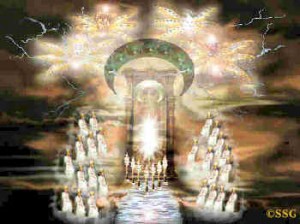Who Are the 24 Elders of Revelation?
 The book of Revelation describes a group of people known as the twenty-four elders, who surround the throne of God in heaven and who sing his praises.
The book of Revelation describes a group of people known as the twenty-four elders, who surround the throne of God in heaven and who sing his praises.
Who are they?
One clue is the number twenty-four.
A suggestion that some scholars have made is that there seem to have been twenty-four courses of Jewish priests in the first century.
This is a possibility, but the twenty-four courses of Jewish priests served one after each other, not all twenty-four at once. They also, obviously, included more than one priest each.
It’s possible that the number of courses of Jewish priests played a role in the shaping of this text (or, from a heavenly perspective, visa-versa), but it seems to me that there is an even more obvious significance to the number 24 that would suggest itself to the original readers: It’s 12+12, and the Church at this time was acutely aware of the fact that it represents a fusion of the original Israel (with its twelve tribes/tribal patriarchs) and the new Israel (with its twelve apostles).
We even see fusion imagery like that at the end of the book, where New Jerusalem is depicted as having twelve foundations, named after the twelve apostles of the Lamb, and twelve gates, named after the twelve tribes of Israel.
So I’ve always thought that, while the courses of priests might have some role here, the more natural interpretation is that the number twenty-four is based on the number of the patriarchs and apostles.
I was thus pleased when I was reading an audience of John Paul II in which he said this:
In this regard, the first passage of our Canticle is significant. It is set on the lips of the 24 elders who seem to symbolize God’s Chosen People in their two historical phases, the 12 tribes of Israel and the 12 Apostles of the Church [General Audience of Jan. 12, 2005].
I always love it when I discover the pope expressing an opinion I’ve long held. I take it as a sign I’ve been on the right track.
There is also something else interesting about this passage: John Paul II said that the twenty-four elders “seem to symbolize.” That language is significant. The pope isn’t teaching that they are or that we must believe this is what they symbolize. He is proposing this view as plausible rather than imposing it as mandatory.
An awareness of the difference between these modes of language is important for correctly interpreting magisterial documents and the mind of the Church, and this passage offers a good illustration of the point. The Magisterium can invoke different levels of authority for propositions. In some cases propositions as proposed but not imposed. In other cases they are authoritatively proclaimed. And in rare cases they are even infallibly proclaimed.
The proper interpretation of magisterial documents thus involves not just recognizing what is being said but also what level of authority is being invested in it, neither understating that level (as dissidents tend to) nor exaggerating it (as a kind of reflexive infallibilism tends to), but correctly assessing and determining the level of authority that was intended by the Magisterium.
